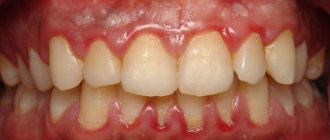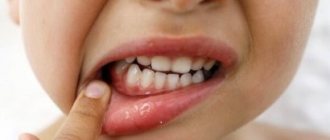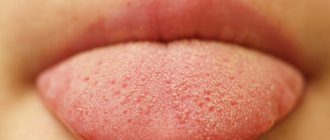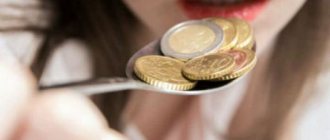Lichen planus
If you have problems with the oral cavity, it is important that you consult a periodontist in a timely manner. This is the only way to accurately determine the cause of the disease and prescribe the correct treatment. The sooner the patient sees a doctor, the easier and faster the therapy. In the case of lichen ruber, which is flat in nature, the oral cavity is covered with a whitish film. Pathological bubbles appear on the mucous membrane, where an admixture of blood inclusions is clearly visible.
The disease occurs as a result of immune disorders, which causes inflammation. The pathology is provoked by chronic stress, emotional turmoil, digestive disorders, liver and pancreas disorders. Some experts believe that the disease is associated with disorders of the cardiovascular and endocrine systems, and hypertension. The disease occurs due to injuries, in patients who come into contact with substances for film development, as well as during long-term tetracycline therapy.
Leukoplakia
This disease usually causes a plaque on the roof of the mouth in an adult. Painful blisters form as the mucous membrane becomes keratinized. White thickenings appear as a result of exposure to pathological agents on the mucosa. This could be alcohol, tobacco smoke, spicy and spicy foods. Sometimes the disease develops as a side symptom of long-term medication use.
Tonsillitis
The development of tonsillitis is associated with the penetration of various infections into the body:
- Staphylococci, streptococci;
- Pneumococci and chlamydia;
- Anaerobic organisms or fungi;
- Haemophilus influenzae and cabsiella;
The acute form of the disease is caused by chronic rhinitis, caries, and chronic pharyngitis.
How does the infection manifest and why is it dangerous?
The most striking symptom of oral candidiasis is a white, loose coating on the mucous membrane. It mainly covers the tongue, cheeks, and may affect the gums and palate. Plaque can be easily scraped out; the tissue underneath is prone to redness and may bleed. Other signs of the disease include:
- unpleasant taste;
- dry mouth;
- burning;
- the appearance of cracks in the corners of the lips;
- difficulty or painful swallowing;
- unpleasant sensations with habitual movements of the tongue.
Candidiasis can be acute or chronic. In most cases, it is the acute form that manifests itself; the chronic form is typical for carriers of HIV infections and smokers. Depending on the degree and form of the disease, other symptoms may be observed, so even if one or two appear, you should immediately contact your dentist.
Causes of white plaque on gums
Candidiasis
The most likely cause of such symptoms is infection with microscopic fungi of the genus Candida, relatives of common culinary yeast. Candida is an opportunistic organism that is present in the microflora of healthy people and animals. However, if the concentration of the fungus on the surface of the mucous membranes exceeds a certain critical threshold, its vital activity leads to the appearance of a number of unpleasant symptoms. One of the main manifestations of candidiasis is the formation of a white coating, which can cover both small and large areas of mucous membranes. This plaque consists of fibrin, bacterial mass, waste products of microorganisms, and pseudomycelium of the fungus Candida. When it is scraped off, areas of ulceration and maceration (softening) of the mucosa are revealed.
A white spot on the gum is not the only manifestation of this disease; the fungus can also affect the mucous membranes of the palate, the inside of the cheeks, the tongue, the corners of the lips, and the bottom of the mouth. In addition, candidiasis is often accompanied by the appearance of such unpleasant symptoms as burning, dryness, and soreness in the mouth; Systemic signs of infection may also occur - fever, nausea, headaches, general weakness and malaise.
Treatment and prevention of candidiasis include the use of antifungal and antiseptic drugs, agents that accelerate the regeneration of damaged epithelium. Good results are achieved by regular use of rinses with disinfecting components - for example, chlorhexidine and benzydamine, which are part of the ASEPTA rinse, are active against a wide range of pathogens. The use of such remedies helps get rid of inflammation and bleeding, reduce the risk of developing a secondary infection and speed up recovery.
Leukoplakia
If the gums turn white in an adult, especially a smoker, this may be a sign of leukoplakia. Leukoplakia is not a disease in the literal sense of the word - it is only a pathological condition, which, however, often precedes the development of cancer. As a rule, this condition occurs as a result of constant exposure of the mucous membranes to one or another irritant - chemical, mechanical, temperature. As a result, hyperkeratosis occurs - keratinization of the upper layer of the mucous membrane. The appearance of white plaque is one of the signs of hyperkeratosis. Leukoplakia plaque is difficult to scrape off even with considerable effort.
Leukoplakia can be caused by exposure to chemicals contained in tobacco, the atmosphere, liquids or food, irritation of the mucous membrane due to contact with the sharp edge of a tooth or denture, too cold or hot food, galvanic current in the mouth due to the presence of metal fillings. Such processes occur in the mouth when it contains dentures containing various metals.
Treatment consists primarily of eliminating traumatic factors. Patients are also advised to use agents that accelerate tissue regeneration. One of these products is ASEPTA gel with propolis. Its regular use helps reduce itching and pain symptoms and quickly restore damaged mucous membranes.
Stomatitis
A white spot on the gum may be a sign of stomatitis, an inflammatory disease of the oral cavity. This spot is caused by the activity of one or another pathogenic microorganism. Most often, stomatitis manifests itself in the form of small white dots or spots, which over time can degenerate into ulcers. It is easy to cope with this disease at the initial stage: often it is enough to use antiseptic rinses and special medicinal gels.
For this purpose, we recommend using ASEPTA and ASEPTA Fresh rinses. They contain broad-spectrum antibacterial components, as well as substances that help eliminate inflammation, bleeding and other unpleasant symptoms of stomatitis. No less effective is the adhesive balm ASEPTA, which has a long-lasting effect on the affected areas of the mucous membranes. ASEPTA balm is also excellent for the treatment of other inflammatory diseases, periodontitis and gingivitis, which in some cases can also lead to the formation of white spots and spots.
Neoplasms
If a white spot on the gum hurts when pressed, it may be a sign of neoplasms such as a cyst or wen. In most cases, these formations do not pose a serious health hazard, but sometimes they have to be removed surgically. In children, there are also Bohn's nodes and Epstein's pearls - small cysts formed from the remains of the salivary glands, dental plates, and various epithelial inclusions. They most often do not cause unpleasant symptoms and go away on their own without special treatment.
Causes of oral candidiasis
How does the disease occur? The fungus Candida lives in the body from birth and, under certain circumstances, provokes illness. What becomes the trigger for infection:
- weakened immunity;
- taking antibiotics;
- long-term use of removable dentures, especially if they do not fit tightly;
- insufficient oral hygiene;
- smoking;
- oncology;
- use of inhalers for asthma;
- excess simple carbohydrates in the diet;
- pregnancy period;
- infancy or old age.
It can be seen that there are many reasons, often they act together, less often - individually. In general, oral candidiasis is rare in adults. It mainly affects children in the first years of life and older people. Among these categories, the prevalence of the disease reaches 10%.
Treatment
Correctly prescribed treatment will quickly eliminate symptoms. Complex therapy will be the most effective.
- Local treatments are recommended for healing ulcers. Special gels and ointments prevent the proliferation of pathological bacteria.
- Soreness and fever are relieved with the help of painkillers and antipyretics.
- Those factors that provoke the disease are eliminated.
In addition, the diet is selected, the bite is corrected, and concomitant diseases are treated. Drugs prescribed:
- Against candidiasis - “Chlorhexidine”, “Stomatofit”, “Rotokan”;
- Rinse solutions;
- Combined-action medications, for example, Cholisal-gel.
- Vitamins to strengthen the body's defenses.
- Calcium supplements to reduce allergic reactions.
- Iron supplements.
How is oral candidiasis treated?
To begin with, let's say that treatment is necessary, otherwise the infection spreads to the pharynx, tonsils, and gums. Then the disease descends into the lungs, gastrointestinal tract, liver and causes irreparable harm to them.
When the first signs of candidiasis of the oral mucosa appear, you should contact your dentist or therapist to confirm the diagnosis. When you see your doctor, describe all your symptoms, even those that are not on the list. For example, you have noticed increased anxiety or a tendency to stress lately. Information about the medications you are taking, recent illnesses, and being around sick people is also important. To confirm the diagnosis, it is often enough to take a swab from the oral cavity and carry out the appropriate analysis. If the disease has already spread to other organs, a more thorough examination may be required, for example, endoscopy - diagnosing the condition of the esophagus and stomach using a flexible tube with a camera at the end.
How to treat oral candidiasis? Treatment can be local or systemic depending on the form and stage of the disease. When local, antifungal agents and antiseptics are prescribed. These can be sprays, rinses, gels, lozenges and more. Treatment on average takes up to 3 weeks, as a general rule - until symptoms disappear and another week. Systemic treatment is used for chronic forms or when the infection spreads to other organs. It usually involves the use of more medications that are intended to treat the directly affected areas.
Under no circumstances resort to self-medication! A fungal infectious disease has nothing to do with inflammation, so your actions are more likely to harm your body. In doing so, you can reduce the harmful effects of the infection and make you feel better. To do this, eat natural yogurt without sugar and take probiotics as recommended by your doctor. But these actions are not a complete treatment for candidiasis in the mouth!
Diagnostics
To cure plaque in the mouth on the roof of your mouth, you need to find out the cause of the disease. To do this, you need to carry out diagnostic procedures. Research begins with a visual examination and medical history. Besides:
- A clinical and sugar blood test is done;
- A scraping is taken from the pathological area;
- Submits urine for analysis;
Blood is tested for viruses and fungi. A biopsy of the affected tissue is performed. Also, the body’s defenses are assessed and the sensitivity of drugs to the pathogen is determined. If there is a suspicion of the development of syphilis, a special Wasserman test is used. Giardiasis is clarified using instrumental diagnostics of the abdominal organs. After laboratory tests, the correct prescription can be made.
How to avoid candidiasis?
To prevent the disease, you must follow a few simple rules:
- maintain oral hygiene;
- consult a dentist at least twice a year, even if there are no complaints;
- control nutrition, avoid excess carbohydrates in food;
- refrain from smoking, which can cause a chronic form of the disease.
Treatment of candidiasis of the oral mucosa can take a long time and also cause irreparable harm to health, so we recommend that you take care of yourself in advance by following preventive measures. If symptoms have already begun to appear, consult a doctor as soon as possible so that the infection does not have time to spread to other organs. You can undergo oral cavity diagnostics at Comfort Dentistry. Our specialists will tell you in detail about the prevention of common diseases of teeth and gums, and also, if necessary, provide high-quality treatment.
Why do you need to clean your tongue?
Brushing your tongue twice a day not only cleanses it of bacteria. This cleaning eliminates four problems.
- Prevents the development of caries
by preventing microorganisms from producing acid that destroys enamel. - Removes bad breath
because bacteria do not produce odorous substances. - Removes plaque
- a breeding ground for bacteria. - Increases the sensitivity
of taste buds - a clean tongue senses the flavors of food and drinks more clearly.
When caring for your tongue, it is worth remembering that not every coating is a sign of some problems. There is also a healthy plaque that can be easily removed with proper hygiene.
Healthy plaque
can be easily distinguished by several signs.
- It is formed
in the morning, after eating or during thirst; - disappears
after cleansing; - changes color
due to coloring by products; - through it you can see
the surface of the tongue; - it doesn't smell
.
Unhealthy plaque can be a symptom of many health problems: diseases of the stomach and intestines, dysfunction of the liver and kidneys, infections in the body (whooping cough, foot and mouth disease, scarlet fever, pityriasis rosea), as well as a consequence of taking antibiotics.
This is what characterizes an unhealthy plaque
.
- It remains
even after thorough cleaning; - It smells
bad ; - very dense and quickly restored
after cleaning; - regardless of food, the color ranges
from yellow to brown; - accompanied by
redness, swelling and cracks of the tongue, nausea, bitterness in the mouth, gastrointestinal upset, etc.
If the plaque is deep yellow or gray-yellow, you should pay attention to the gastrointestinal tract - you may have gastritis, ulcers, pancreatitis. And if frequent and severe heartburn occurs, the plaque will turn yellow-orange.
But we must remember that harmful plaque is not always caused by some disease. It can appear due to an unhealthy lifestyle: smoking, a large amount of dyes in foods, poor hygiene, even due to caries and bleeding gums. Brushing your tongue with a toothbrush will not solve this problem - you need to contact a specialist to understand how to proceed.
How to clean your tongue
Do not use regular toothbrushes for cleaning - they will not be able to remove plaque. It is better to pay attention to special tongue cleaning products.
Scrapers
The most common devices are scrapers. The tips of the scrapers are made in the shape of a spoon. They are usually made of plastic, sometimes with stiff bristles. The flat shape prevents the gag reflex that may occur when brushing the root of the tongue. This scraper needs to be changed every six months.
Irrigator attachments
Tongue attachments are also made in the form of a spoon. The irrigator, unlike a conventional scraper, delivers a stream of water, which additionally washes the surface of the tongue.
Attachments for electric brushes
Most brush manufacturers offer special attachments for their products to clean tongue deposits. As a rule, they have a flat, textured rubber surface.
Tongue gels
You should not clean your tongue with toothpaste - it is intended for teeth. Pastes contain abrasives and menthol, they can irritate the mucous membrane. Special gels that gently dissolve plaque and also disinfect the oral cavity are better suited for the tongue.
How to clean your tongue
If you don't have any health problems that affect the plaque, just follow these guidelines and remember to brush until all the plaque is removed and your tongue is pink again. Typically, tongue hygiene takes only 20–30 seconds.
Recommendations for adults
- Proceed with the procedure only after brushing your teeth
and rinsing your mouth. - Use special tools
: scrapers, nozzles and others. - Clean your tongue using sweeping movements
and light pressure. - Start from the root of the tongue
and end with the tip. - Do not brush your tongue with cross movements and do not press
too hard - this can damage it. - Don't forget to clean the instrument
after the procedure. - Be sure to rinse your mouth
with water.
Should children have their tongues cleaned?
Children also need tongue care, but not earlier than 3–4 years.
For younger children, tongue cleaning is pointless. They don’t eat junk food, especially not in the same quantities as adults, and they don’t drink tea and coffee. Until 3–4 years of age, normal oral care is sufficient. From 3–4 to 8 years
This is how you should clean your tongue.
- Move from the root of the tongue to the tip
with smooth sweeping movements, with even weaker pressure than with adults. - Similarly, clean the sides
of the tongue and the inside of the cheeks. - Be sure to rinse your mouth
.
From the age of 8
you can already use scrapers.











